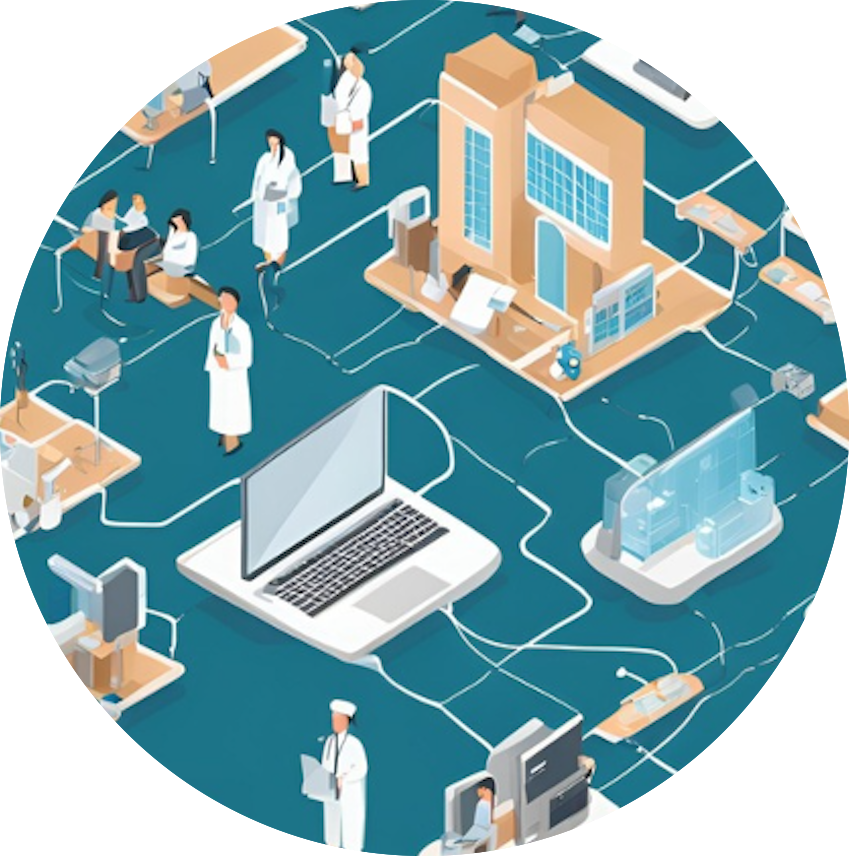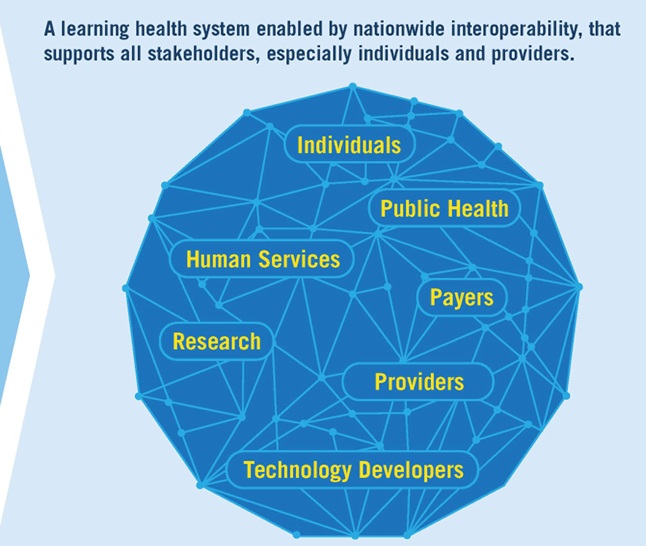Phones and Live Chat are not available today. CDR Staff will respond to emails and voicemails within 48 business hours.
Interoperability and Health Information Standards

- Overview
- Interoperability and Standards Committee
- HL7 Fast Healthcare Interoperability Resource (FHIR)
- Published Nutrition Standards
- Additional Interoperability & Standards Resources
- Resources to Support How to Demonstrate Quality Nutrition Care
Interoperability ensures that health information is secure, accessible, and can be exchanged between health information systems for the purposes of demonstrating and improving health care outcomes including nutrition outcomes. Health information technology standards provide the expectations and rules for data sharing among health information systems. The international standards setting organization for electronic health records (EHRs) is Health Level Seven (HL7). Standards, combined with standardized health terminologies, promotes meaningful exchange of health information.
To learn more, contact us at quality@eatright.org.
CDR's Interoperability and Standards Committee works to ensure the nutrition care process is consistently supported in healthcare systems. We develop standards—agreed-upon ways of doing things—that improve how nutrition information is collected, used, and shared. This interoperability—the ability of different systems to exchange and use information—makes nutrition care more efficient and helps improve patient outcomes. These standards provide:
- Clear Communication: We use a common "language" and coding system so that everyone involved in a patient's care understands the nutrition information. This makes it easier to interpret and use the data.
- Consistent Records: Our standards ensure that nutrition documentation is consistent and can be easily used with different medical apps and technologies. This makes it easier for healthcare providers to access and use this important information.
Our committee is made up of 9 credentialed practitioners who are committed to making a meaningful impact. We are looking for passionate, dedicated individuals ready to collaborate and contribute to the community. If you are interested in applying please see CDR Volunteer Opportunities to learn more.
FHIR (pronounced "fire") is a standard used to make healthcare data easier to share and exchange between different systems, like hospitals, clinics, and insurance companies. FHIR consists of resources which are predefined data structures for specific pieces of healthcare data. The following are the available nutrition-related resources:
- NutritionOrder: this resource describes a request for oral diets, oral nutrition supplements, enteral nutrition, and infant formula in the inpatient setting as well as other settings (eg, outpatient, home health). This resource captures the type of oral diet, any nutrient restrictions, and any texture modifications. For supplements, the resource captures the product, schedule, amount, and any special instructions. For enteral nutrition orders, the resource captures the product type and name, route of administration, scheduling, quantity, rate, and more. Modular additives are also accounted for.
- NutritionIntake: this resource describes intake by a patient. It allows for recording of food, liquid, breastmilk, infant formula, oral nutrition supplements, and enteral formula. The resource captures the item consumed (or not consumed), the amount, timing, and total nutrient and/or energy consumed.
- NutritionProduct: this resource describes a food (solid or liquid) or supplement product that can be consumed by a patient. The NutritionIntake resource references the NutritionProduct resource within its structure. This resource also captures the nutritional information, ingredients, and allergens for each product.
Standards published to support the nutrition care process:
- HL7 Domain Analysis Model: Nutrition Care, Release 3: STU (standard for trial use) published in December 2022: Provides the business use case for nutrition and shows workflow activity diagrams, information models with the flow of data, and other details of nutrition care. While previous version focused only on diet orders of inpatients, this version includes the entire nutrition care process and includes outpatient examples as well.
- HL7 EHR-System Electronic Nutrition Care Process Record System (ENCPRS) Functional Profile, Release 2: Details the functions that should be contained in an electronic health records (EHR) to support the nutrition care process (NCP) and the terms from the nutrition care process terminology (NCPT) promoting information interoperability between nutrition, food systems, and other areas of healthcare.
- United States Core Data for Interoperability (USCDI): nationwide Standardized data set for interoperable health information exchange. It consists of nutrition related elements such as Nutrition Order and Nutrition Status.
Terminologies
| Acronym | Full Name | Description |
|---|---|---|
| SNOMED | Systematized Nomenclature of Medicine - Clinical Terms | A comprehensive, multilingual healthcare terminology that provides codes, terms, synonyms, and definitions used in clinical documentation and reporting. Learn more |
| eNCPT | Electronic Nutrition Care Process Terminology | An online publication of standardized nutrition terminology supporting the Nutrition Care Process, facilitating clear communication among dietetics professionals. Learn more |
| UMLS | Unified Medical Language System | A set of files and software that brings together many health and biomedical vocabularies and standards to enable interoperability between computer systems. Learn more |
Data Standards and Repositories
| Acronym | Full Name | Description |
|---|---|---|
| FHIR | Fast Healthcare Interoperability Resources | A next-generation standards framework created by HL7 for exchanging electronic health information, designed to be more flexible and easier to implement than older HL7 standards. Learn more |
| LOINC | Logical Observation Identifiers Names and Codes | A universal standard for identifying health measurements, observations, and documents to facilitate the exchange and aggregation of clinical results for care delivery, outcomes management, and research. Learn more |
| USCDI | United States Core Data for Interoperability | A standardized set of health data classes and constituent data elements for nationwide, interoperable health information exchange. Learn more |
| VSAC | ValueSet Authority Center | A repository and authoring tool for value sets that support the definition and maintenance of reusable sets of codes, provided by the National Library of Medicine (NLM). Learn more |
Standards Organizations and Advisory Resources
| Acronym | Full Name | Description |
|---|---|---|
| HL7 | Health Level Seven International | An ANSI-accredited organization that develops standards for the exchange, integration, sharing, and retrieval of electronic health information. Learn more |
| ISA | Interoperability Standards Advisory | A catalog maintained by the Assistant Secretary for Technology Policy and the Office of the National Coordinator for Health IT (ASTP/ONC) that provides information on interoperability standards and implementation specifications for healthcare. Learn more |
| ASTP/ONC | Assistant Secretary for Technology Policy/Office of the National Coordinator for Health Information Technology | A division of the U.S. Department of Health and Human Services. ONC coordinates nationwide efforts to implement advanced health information technology and the electronic exchange of health information. ASTP coordinates broader technology policy initiatives across federal agencies. Learn more |
Organizations and Groups
| Acronym | Full Name | Description |
|---|---|---|
| NIDPG | Nutrition Informatics Dietetic Practice Group | A practice group within the Academy of Nutrition and Dietetics focusing on the integration of nutrition and information technology to improve health outcomes. Learn more |
Resources and Educational Materials
| Acronym | Full Name | Description |
|---|---|---|
| NCP page | Nutrition Care Process Page | Provides information on the Nutrition Care Process, a systematic approach to providing high-quality nutrition care. For more information, visit: CDRnet.org and NCPro.org. |
| GMCS | Global Malnutrition Composite Score | First nutrition-focused Centers for Medicare and Medicaid (CMS) electronic clinical quality measure (eCQM). For More information, visit: CDRnet.org and eCQI resource center. |
| Research Article | Hamady CM, Pellechia K, Atkinson BE, et al. 2019 Nutrition Informatics Survey: Results and Future Directions. J Acad Nutr Diet. 2021;121(11):2301-2309. doi:10.1016/j.jand.2020.12.009 (sign-in required) | Starting in 2007 and approximately every three to four years following, the Academy has conducted a survey related to the use of technology by nutrition and dietetics practitioners. |
Data Platforms
| Acronym | Full Name | Description |
|---|---|---|
| ANDHII | Academy of Nutrition and Dietetics Health Informatics Infrastructure | A web-based system that allows practitioners to collect and manage outcomes data from nutrition interventions, supporting evidence-based practice and research. Learn more |
- November 2024: Harnessing the Power of Data by Elevating Documentation to Enhance Patient Care - 1 CPEU
- Freely available Nutrition Care Process terms
- CPE Offerings and Resources
